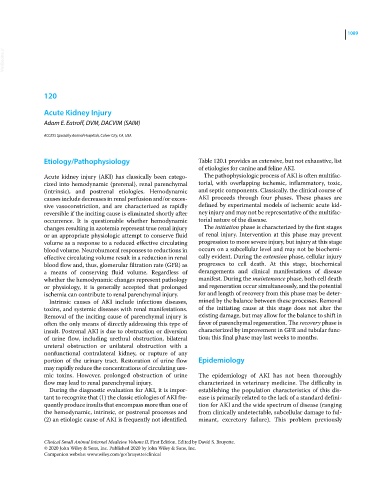Page 1151 - Clinical Small Animal Internal Medicine
P. 1151
1089
VetBooks.ir
120
Acute Kidney Injury
Adam E. Eatroff, DVM, DACVIM (SAIM)
ACCESS Specialty Animal Hospitals, Culver City, CA, USA
Etiology/Pathophysiology Table 120.1 provides an extensive, but not exhaustive, list
of etiologies for canine and feline AKI.
Acute kidney injury (AKI) has classically been catego- The pathophysiologic process of AKI is often multifac-
rized into hemodynamic (prerenal), renal parenchymal torial, with overlapping ischemic, inflammatory, toxic,
(intrinsic), and postrenal etiologies. Hemodynamic and septic components. Classically, the clinical course of
causes include decreases in renal perfusion and/or exces- AKI proceeds through four phases. These phases are
sive vasoconstriction, and are characterized as rapidly defined by experimental models of ischemic acute kid-
reversible if the inciting cause is eliminated shortly after ney injury and may not be representative of the multifac-
occurrence. It is questionable whether hemodynamic torial nature of the disease.
changes resulting in azotemia represent true renal injury The initiation phase is characterized by the first stages
or an appropriate physiologic attempt to conserve fluid of renal injury. Intervention at this phase may prevent
volume as a response to a reduced effective circulating progression to more severe injury, but injury at this stage
blood volume. Neurohumoral responses to reductions in occurs on a subcellular level and may not be biochemi-
effective circulating volume result in a reduction in renal cally evident. During the extension phase, cellular injury
blood flow and, thus, glomerular filtration rate (GFR) as progresses to cell death. At this stage, biochemical
a means of conserving fluid volume. Regardless of derangements and clinical manifestations of disease
whether the hemodynamic changes represent pathology manifest. During the maintenance phase, both cell death
or physiology, it is generally accepted that prolonged and regeneration occur simultaneously, and the potential
ischemia can contribute to renal parenchymal injury. for and length of recovery from this phase may be deter-
Intrinsic causes of AKI include infectious diseases, mined by the balance between these processes. Removal
toxins, and systemic diseases with renal manifestations. of the initiating cause at this stage does not alter the
Removal of the inciting cause of parenchymal injury is existing damage, but may allow for the balance to shift in
often the only means of directly addressing this type of favor of parenchymal regeneration. The recovery phase is
insult. Postrenal AKI is due to obstruction or diversion characterized by improvement in GFR and tubular func-
of urine flow, including urethral obstruction, bilateral tion; this final phase may last weeks to months.
ureteral obstruction or unilateral obstruction with a
nonfunctional contralateral kidney, or rupture of any
portion of the urinary tract. Restoration of urine flow Epidemiology
may rapidly reduce the concentrations of circulating ure-
mic toxins. However, prolonged obstruction of urine The epidemiology of AKI has not been thoroughly
flow may lead to renal parenchymal injury. characterized in veterinary medicine. The difficulty in
During the diagnostic evaluation for AKI, it is impor- establishing the population characteristics of this dis-
tant to recognize that (1) the classic etiologies of AKI fre- ease is primarily related to the lack of a standard defini-
quently produce insults that encompass more than one of tion for AKI and the wide spectrum of disease (ranging
the hemodynamic, intrinsic, or postrenal processes and from clinically undetectable, subcellular damage to ful-
(2) an etiologic cause of AKI is frequently not identified. minant, excretory failure). This problem previously
Clinical Small Animal Internal Medicine Volume II, First Edition. Edited by David S. Bruyette.
© 2020 John Wiley & Sons, Inc. Published 2020 by John Wiley & Sons, Inc.
Companion website: www.wiley.com/go/bruyette/clinical

